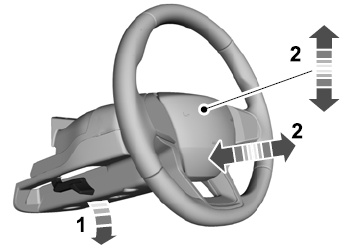Lincoln Aviator 2020-2025 Service Manual / Chassis / Suspension / Suspension System - General Information / General Procedures - Ride Height Measurement
Lincoln Aviator: Suspension System - General Information / General Procedures - Ride Height Measurement
Special Tool(s) / General Equipment
| Surface Gauge |
Check
NOTE: Make sure that the vehicle is positioned on a flat, level surface and the tires are inflated to the correct pressure. Vehicle should have a full tank of fuel.
-
Before measuring ride height check:
-
Tires are inflated to the correct pressure.
-
Vehicle should have a full tank of fuel.
-
All fluids at proper levels.
-
No cargo inside the cab or bed.
-
Inspect for aftermarket equipment. Check for
aftermarket changes to the steering, suspension, wheel and tire
components (such as competition, heavy duty, etc.).
-
Tires are inflated to the correct pressure.
-
Jounce front and rear suspension vigorously to allow the vehicle to settle.
Ride Height Measurement — Front
-
-
Ride height = 3-2
-
Measure the distance between the flat level
surface and the center of the rear control arm ball joint cap
(measurement 2)
-
Measure the distance between the flat level
surface and the center of the rear control arm inboard bolt (measurement
3)
Use the General Equipment: Surface Gauge
-
Ride height = 3-2
.jpg) |
-
With the surface gauge positioned on a flat, level
surface, record the measurement of the surface gauge position
(measurement 2) and (measurement 3).
Use the General Equipment: Surface Gauge
.jpg) |
-
Subtract measurement 2 from measurement 3 to obtain the front ride height.
Ride Height Measurement — Rear
-
-
Ride height = 2-3
-
Measurement 2
-
Measurement 3
Use the General Equipment: Surface Gauge
-
Ride height = 2-3
.jpg) |
-
Measure the distance between the flat level surface
and the center of the toe link inboard cam bolt (measurement 2).
-
Measure the distance between the flat level surface
and the center of the toe link outboard bolt (measurement 3).
-
Subtract measurement 3 from measurement 2 to obtain the rear ride height.
 General Procedures - Rear Toe Adjustment
General Procedures - Rear Toe Adjustment
Special Tool(s) /
General Equipment
Wheel Alignment System
Adjustment
NOTICE:
Do not use any tools or equipment to move the wheel and tire
assembly or suspension components while checking for relative movement...
Other information:
Lincoln Aviator 2020-2025 Service Manual: Description and Operation - Direct Current/Alternating Current (DC/AC) Inverter - System Operation and Component Description
System Diagram System Operation Network Message Chart Broadcast Message Originating Module Message Purpose Power pack torque status Secondary On-Board Diagnostic Control Module C (SOBDMC) Used to determine if the vehicle is started or if torque is available...
Lincoln Aviator 2020-2025 Owners Manual: Using the Pre-Collision Assist System
The system is active at speeds above approximately 3 mph (5 km/h) and pedestrian detection is active at speeds up to 50 mph (80 km/h). If your vehicle is rapidly approaching another stationary vehicle, a vehicle traveling in the same direction as yours, or a pedestrian within your driving path, the system is designed to provide three levels of functionality: Alert Brake Support Active Braking Alert: When active, a flashing visual warning appears and an audible warning tone sounds...
Categories
- Manuals Home
- Lincoln Aviator Owners Manual
- Lincoln Aviator Service Manual
- Remove and Reinstall the Battery
- USB Port and Power Point Locations
- Description and Operation - Jacking and Lifting
- New on site
- Most important about car
Adjusting the Steering Wheel - Vehicles With: Manual Adjustable Steering Column
WARNING: Do not adjust the steering wheel when your vehicle is moving.
Note: Make sure that you are sitting in the correct position.
Unlock the steering column. Adjust the steering wheel to the desired position.
Copyright © 2025 www.liaviator2.com

